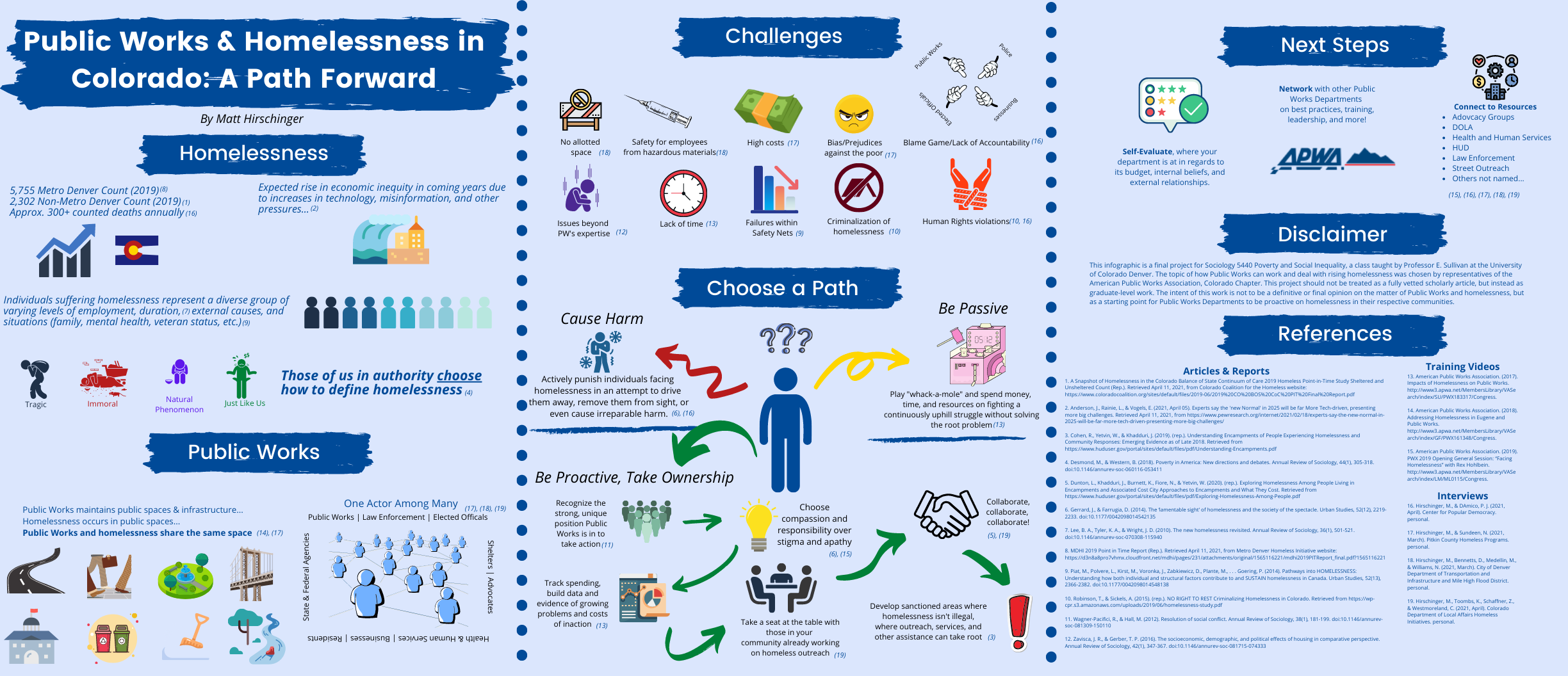
This guest article is by ELGL member Matt Hirschinger, Assistant to the City Manager for the City of Arvada, CO. Read all of Matt’s other articles at the Social Justice –> Government homepage.
My fifth project as part on my ongoing degree and the Social Justice -> Local Government series is an infographic created for the American Public Works Association, Colorado Chapter. When I approached them on what sort of topic(s) will be of use to them that would fit into the class I was taking, they brought up homelessness and the growing fiscal, operational, and moral challenges Public Works departments are facing as the situation worsens.
Here is the poster version of the infographic.
Here is a three-pager version.
At the heart of this infographic is a fundamental question of choice of both empowering and not allowing us to shy away from our personal agency in this difficult conversation.
Homelessness and Individuals Facing Homelessness
Just like anything else it helps to gather some empirical data on trends, statistics, causes and effects on homelessness on both those individuals facing it as well as the communities as a whole. To save some time, what we’ll find is that homelessness is not one issue, but many interrelated issues, and our homeless populations range widely in whether they face homelessness in the short term or chronically and vary on many of levels such as veteran status, mental health, past trauma, and available resources. There is no one-size-fits-all solution as they are not a single one-size-fits-all category of people.
After we’ve gathered our evidence for our specific community to understand the situation better, we come to the more subjective choice of how we engage with our homeless residents, which sub-group(s) we prioritize and allow to define our vision the most. We can base it on where the plurality of homeless residents fall on the spectrum, which groups are most in need, which groups we feel are the most deserving of assistance, all choices that are perfectly valid, all of which are making a distinct choice in favor of others.
With homelessness in our jurisdictions, we make these choices for them.
Public Works
Similarly, Public Works is defined by both facts as well as subjective choices. We understand that Public Works has certain key responsibilities, the development and maintenance of public areas. This can be done with or adjacent to parks and utilities. In regard to the topic at hand, Public Works is responsible for solid waste, to ensure public spaces, right-of-ways, other areas are held to certain standards.
What are the base standards? What are the exceptions, if any? What is the process, speed, and thoroughness of it? All are subjective choices no matter how much quality empirical information we try to accumulate. Ultimately, we decide which statistics we value more, which findings suit our needs better. In local government we like to wash our hands clean of personal choice, to claim we’re just following policies and procedures while at the same time we’re the ones who are responsible for developing said policies and procedures.
Once more, we make these choices for what Public Works is and is not, what are the rules, guidelines, and expectations to live up to.
Forcing the Choice
From what I’ve seen, an even stickier challenge for social justice within local government institutions than blatant forms of prejudice is a reliance on the status quo. We understand that our society is not equitable, therefore something needs to change if we’re to reach greater equity. Explicit bigotry shines bright and painful and is easier to identify. Maintaining the status quo is much harder to contend with, all it takes is someone in a position of influence deciding to keep things the way they are for our efforts to better represent and work with disenfranchised groups to be diminished or even squashed completely.
Maintaining the status quo blurs the line between intentionally and unintentionally being an obstacle, leaving those of us working towards diversity and inclusion unsure of how to best engage the situation. Maintaining the status quo is used as a means to not make a choice, to be neutral, objective, and impartial.
One solution I’ve found is forcing the choice. Make the status quo a choice, which is what I’ve purposefully done in the infographic. It was very intentional on my part to put a bright yellow arrow to drive home the point that hand-wringing, deciding that whatever budgetary and political constraints are too constricting, “being passive”, is taking a path just as much as being proactive.
When we force the choice, when we make doing nothing different than what we have been an option that must be expressed verbally, in writing, through official and unofficial channels, it becomes much easier for us to identify and act upon.
“Make a choice.”
“Well, this is the way we do things…”
“There are alternative options, doing things the way we’ve done things before is one option.”
“I’m not sure we really could change our procedures…”
“There are people within the organization who change procedures, keeping them the same is a decision.”
“It’ll be really hard, and take a lot of time and resources…”
“Time and resources we have if we prioritize it.”
“I’m not sure if other agencies will go along…”
“We’re talking about our agency, our department, and what we’ll do.”
“I’m not the person who can make this call…”
“Then let’s get that person in the room and make sure they’re part of the conversation.”
Keep pressing on making the status quo a choice, and even if the status quo is decided on, it will no longer be hidden, no longer an option to avoid the tough questions. In this case, the tough question upon us is what Public Works will and won’t do, who they will and will not collaborate with, on homelessness? They have an important role to play, and there’s a choice in how Public Works engages their role.
